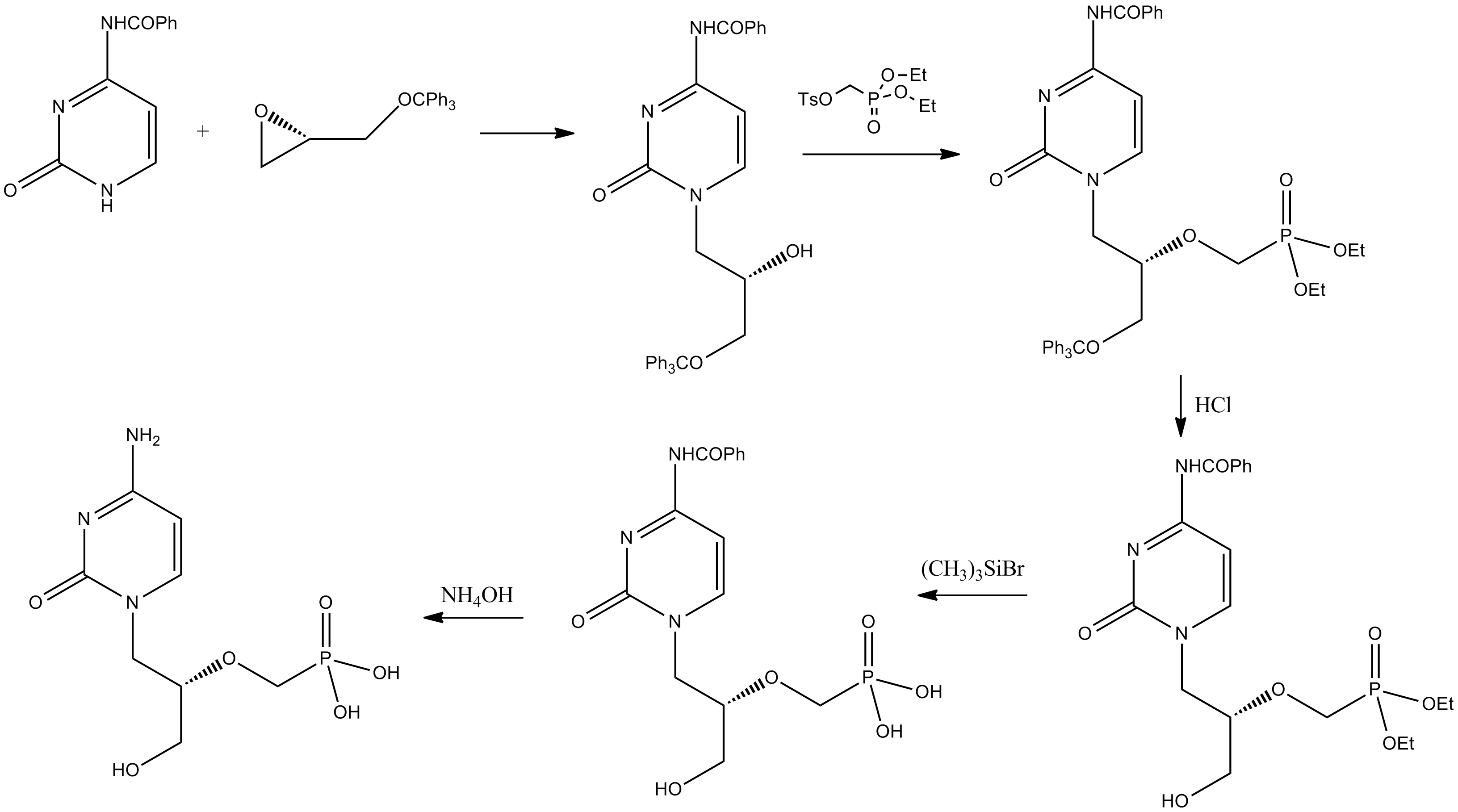Acyclic Nucleoside Phosphonates on:
[Wikipedia]
[Google]
[Amazon]
Cidofovir, brand name Vistide, is a topical or injectable antiviral medication primarily used as a treatment for

cytomegalovirus
''Cytomegalovirus'' (''CMV'') (from ''cyto-'' 'cell' via Greek - 'container' + 'big, megalo-' + -''virus'' via Latin 'poison') is a genus of viruses in the order ''Herpesvirales'', in the family ''Herpesviridae'', in the subfamily ''Betaherpe ...
(CMV) retinitis (an infection of the retina of the eye) in people with AIDS
Human immunodeficiency virus infection and acquired immunodeficiency syndrome (HIV/AIDS) is a spectrum of conditions caused by infection with the human immunodeficiency virus (HIV), a retrovirus. Following initial infection an individual m ...
.
Cidofovir was approved for medical use in 1996.
Medical use
DNA virus
Its only indication that has received regulatory approval worldwide iscytomegalovirus
''Cytomegalovirus'' (''CMV'') (from ''cyto-'' 'cell' via Greek - 'container' + 'big, megalo-' + -''virus'' via Latin 'poison') is a genus of viruses in the order ''Herpesvirales'', in the family ''Herpesviridae'', in the subfamily ''Betaherpe ...
retinitis. Cidofovir has also shown efficacy in the treatment of aciclovir-resistant HSV infections. Cidofovir has also been investigated as a treatment for progressive multifocal leukoencephalopathy
Progressive multifocal leukoencephalopathy (PML) is a rare and often fatal viral disease characterized by progressive damage (''-pathy'') or inflammation of the white matter (''leuko-'') of the brain (''-encephalo-'') at multiple locations (''mu ...
with successful case reports of its use. Despite this, the drug failed to demonstrate any efficacy in controlled studies. Cidofovir might have anti- smallpox efficacy and might be used on a limited basis in the event of a bioterror incident involving smallpox cases. Brincidofovir, a cidofovir derivative with much higher activity against smallpox that can be taken orally has been developed. It has inhibitory effects on varicella-zoster virus replication ''in vitro'' although no clinical trials have been done to date, likely due to the abundance of safer alternatives such as aciclovir. Cidofovir shows anti- BK virus activity in a subgroup of transplant recipients. Cidofovir is being investigated as a complementary intralesional therapy against papillomatosis caused by HPV.
It first received FDA approval on 26 June 1996, TGA approval on 30 April 1998 and EMA approval on 23 April 1997.
It has been used topically to treat warts.
Other
It has been suggested as an antitumour agent, due to its suppression of FGF2.Administration
Cidofovir is only available as an intravenous formulation. Cidofovir is to be administered with probenecid which decreases side effects to the kidney. Probenecid mitigates nephrotoxicity by inhibiting organic anion transport of the proximal tubule epithelial cells of the kidney. In addition, hydration must be administered to patients receiving cidofovir. 1 liter of normal saline is recommended in conjunction with each dose of cidofovir.Side effects
The major dose-limiting side effect of cidofovir is nephrotoxicity (i.e., kidney damage). Other common side effects (occurring in >1% of people treated with the drug) include: * Nausea * Vomiting *Neutropenia
Neutropenia is an abnormally low concentration of neutrophils (a type of white blood cell) in the blood. Neutrophils make up the majority of circulating white blood cells and serve as the primary defense against infections by destroying bacteria ...
* Hair loss
* Weakness
* Headache
* Chills
* Decreased intraocular pressure
* Uveitis
* Iritis
Whereas uncommon side effects include: anaemia and elevated liver enzymes and rare side effects include: tachycardia and Fanconi syndrome. Probenecid (a uricosuric drug) and intravenous saline should always be administered with each cidofovir infusion to prevent this nephrotoxicity.
Contraindications
Hypersensitivity to cidofovir or probenecid (as probenecid needs to be given concurrently to avoid nephrotoxicity).Interactions
It is known to interact with nephrotoxic agents (e.g. amphotericin B, foscarnet, IV aminoglycosides, IV pentamide, vancomycin, tacrolimus, non-steroid anti-inflammatory drugs, etc.) to increase their nephrotoxic potential. As it must be given concurrently with probenecid it is advised that drugs that are known to interact with probenecid (e.g. drugs that probenecid interferes with the renal tubular secretion of, such as paracetamol, aciclovir, aminosalicylic acid, etc.) are also withheld.Mechanism of action
Its active metabolite, cidofovir diphosphate, inhibits viral replication by selectively inhibiting viral DNA polymerases. It also inhibits human polymerases, but this action is 8–600 times weaker than its actions on viral DNA polymerases. It also incorporates itself into viral DNA, hence inhibiting viral DNA synthesis during reproduction. It possesses ''in vitro'' activity against the following viruses: * Human herpesviruses * Adenoviruses * Human poxviruses (including the smallpox virus) * Human papillomavirusHistory
Cidofovir was discovered at the Institute of Organic Chemistry and Biochemistry, Prague, by Antonín Holý, and developed by Gilead Sciences and is marketed with the brand name Vistide by Gilead in the US, and by Pfizer elsewhere.Synthesis
Cidofovir can be synthesized from a pyrimidone derivative and a protected derivative of glycidol. :
See also
* Brincidofovir, a novel prodrug of cidofovir that can be taken orallyReferences
{{Antivirals Gilead Sciences Anti-herpes virus drugs Pyrimidones Amines Ethers Phosphonic acids Primary alcohols